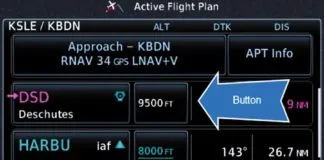Say a Bit More Next Time
Regarding the ATC column “Say More For Less” in your March issue, I really enjoy reading articles like this.
I take ATC very seriously and I’m always interested to know exactly what they are expecting from me. I strive to be as professional as possible in the air, even though I fly just for fun. However, I’m not perfect, and I can certainly be accused of wasting a lot of airtime over the years with something I can’t seem to stop saying to each controller, “Thanks.”
Dave Freeman
Seattle, Wash.
When checking in with a controller while either climbing or descending, I’ve always used the words “climbing” or “descending” instead of “for” to avoid confusion with the number four. For example: “… 900 climbing 2000 …” I don’t know if that’s too loquacious, but there’s no doubt about what the pilot is doing.
Also, I was taught that when checking in with a new controller, you can drop the “Houston Center” or “Boston Approach” because they know who they are, so why repeat it. This does minimize words, but if you happen to have dialed in the wrong frequency, they might not be expecting you and create more confusion. I guess my question is what is your preference?
Andy Reinach
Westborough, Mass.
Using “climbing,” “descending” or “level” is truly the correct way. It even says so in AIM 5-3-1. Controllers we asked about it we’re split on whether this mattered to them or not. It’s no more than an extra syllable or two, so it’s worth doing right.
On your second point, it’s best to check in with their name for two reasons. The first, you mentioned: It’s a check that you’re talking to the right person. The other is that we all are primed to listen for our names and then pay more attention to what comes next. Saying “Houston Center” first is a heads up to the person on the other end of the radio that the important information is coming next and they should spare a few brain cycles to hear it rather than think about dinner or the unfinished tax return or the myriad other things a normal person might happen to be thinking about at just that moment, especially if it’s a quiet night.
Less IFR with Age
Congratulations on five years as editor of IFR magazine. The new format is just gorgeous and a pleasure to read, month in and month out.
Your thoughts on IFR proficiency in the March issue (Remarks) struck home too. Higher fuel prices have impacted my flying and although my partners and I take turns as safety pilot to keep our IFR proficiency up, there’s no question that reduced flying makes us more cautious about the risks we’re willing to take.
That same theme was reinforced in a number of other places in the April issue, culminating in the Killer Quiz. I’m familiar with Roanoke and have flown into Woodrum Field in IMC—on the ILS Rwy 33, a much less challenging approach than the LDA Rwy 6. At this point I have no desire to fly the LDA at night in weather, trying to read the tiny four-point notes from my kneeboard in a darkened cockpit.
We don’t often talk about the fact that, among occupations, commercial pilots have the third highest fatality rate, just behind commercial fishing and logging. Perhaps it’s inevitable that as we age we become more aware of our own mortality. Let me add that to your list of reasons why IFR flying activity is trending downward.
Jim Grant
via email
Your March editorial touched a nerve. The NDBs are disappearing faster than the NOTAMS keep up, my LORAN died on February 8, the VORs will be decommissioned soon and there is no way I can afford nor justify putting a $15,000 IFR GPS in my $30,000 ’65 Skyhawk.
Even then I’d have no real backup for a system that is easily compromised despite FAA’s claims. In the early days of aviation, IFR was out of reach for most in general aviation and my expectation is that this will be the situation in the future as well for a large segment. I’ll probably maintain currency (if I can) and that might save my bacon some day, but as a 62-year-old, mostly-retired person I can just wait for the weather to improve and enjoy visual flying.
Jim Bailey
Yellow Springs, Ohio
VFR is Cheaper
In your April Remarks section, you ask, “Is there a shift away from flying in the system?”
My personal preference is to fly VFR when I can and to use the IFR system only when I must. VFR is much more efficient in time and cost. IFR involves contention for precious airspace with the attendant delays and longer routes. I have found that even controllers like it better when you can maintain VFR and elect to do so, before having to go IFR. It is less work for them and gives them options in getting you across some busy corridors they otherwise would not have.
Because of these factors, I often mix VFR and IFR in the same flight, staying VFR as much as possible instead of going IFR the whole way.
So perhaps there is a good reason to an increased use of VFR.
Phil Sih
Reno, Nevada
Don’t Ditch the ADF Yet
I am a current subscriber to IFR and have a question about GPS in lieu of ADF for NDB approaches. I know they were approved 12-14 years ago for NDB with a GPS overlay, but can they now be used in lieu of ADF when it is just an NDB approach? If not, would FAA require installation of an ADF in a newer plane when NDB approaches will be flown? This seems absurd to me. Can you explain?
We only have two approaches at La Grande. The other is a GPS approach that has an IAF 35 miles north and an extra hour in IMC if you’re arriving from the south.
R.H. Ettinger
La Grande, Ore.
Unless it says “or GPS” in the title of the approach, then using your GPS in lieu of the primary navaid (NDB, SDF, whatever) is not kosher.
When you load the NDB-B approach, you’ll see a warning that it’s advisory only. With the plan to phase out NDBs, we doubt this policy will change. You’ll have to wait for a new RNAV (GPS) approach from the south.
That said, in an emergency (or, perhaps, to avert one), would we be willing to fly the NDB approach using an IFR GPS? In a New York minute.
Send your comments to ifr.editor@gmail.com




